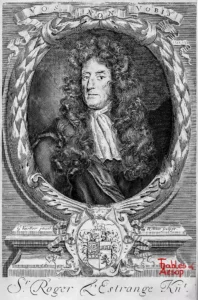
The fables marked with the symbol to the right represent 1692 translations by Sir Roger L’Estrange, an English journalist. Praised at the time of printing, the L’Estrange translations are today fairly hard to read.
In an effort to help, some definitions of uncommon words have been added to the end of fables where necessary. The meaning of other words and abbreviations can be obtained from the context.
L’Estrange was born in Hunstanton on 17 Dec 1616 and died on 11 Dec 1704. He was active in politics as a Royalist supporter and escaped hanging as a spy in 1644. He was instead imprisoned in Newgate, but escaped four years later. In 1653 he was pardoned by Cromwell. During the Restoration he was an active pamphleteer, taking on all the issues of the day. As one example, his pamphlet No Blinde Guides published in 1660 attacked the poet John Milton who was leading the arguments for a Commonwealth.
He is also famous for his papers The Public Intelligencer (1663-1666) and The Observer (1681-1687). He was knighted in 1685 after he discredited the “Popish Plot” (a story circulating that the Jesuits had plans to kill King Charles II).
After he lost his official status when King James II left the throne (1688) L’Estrange translated texts to support himself.
In addition to Aesop’s Fables, he translated Seneca’s Morals, Cicero’s Offices, the Colloquies of Erasmus, and Quevedo’s Visions.
